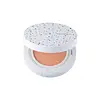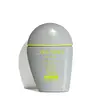What's inside
What's inside
 Key Ingredients
Key Ingredients

 Benefits
Benefits

 Concerns
Concerns

 Ingredients Side-by-side
Ingredients Side-by-side

Water
Skin ConditioningZinc Oxide
Cosmetic ColorantButylene Glycol Dicaprylate/Dicaprate
EmollientTitanium Dioxide
Cosmetic ColorantIsododecane
EmollientButylene Glycol
HumectantButyloctyl Salicylate
Skin ConditioningHexyl Laurate
EmollientPolyglyceryl-3 Polyricinoleate
EmulsifyingNiacinamide
SmoothingTrimethylsiloxysilicate
EmollientC18-21 Alkane
SolventCI 77891
Cosmetic ColorantMagnesium Sulfate
Polyglyceryl-3 Diisostearate
EmulsifyingPolyglyceryl-4 Isostearate
EmulsifyingAluminum Hydroxide
EmollientCaprylic/Capric Glycerides
EmollientStearic Acid
CleansingSilica
AbrasiveQuaternium-90 Bentonite
Polymethyl Methacrylate
Mica
Cosmetic ColorantC13-14 Isoparaffin
EmollientAcrylates/Polytrimethylsiloxymethacrylate Copolymer
Skin ConditioningTriethoxycaprylylsilane
1,2-Hexanediol
Skin ConditioningPolyglyceryl-3 Ricinoleate
EmulsifyingTrimethylsiloxysilicate/Dimethiconol Crosspolymer
Lecithin
EmollientPolyhydroxystearic Acid
EmulsifyingAdenosine
Skin ConditioningIsostearic Acid
CleansingIsopropyl Myristate
EmollientEthylene/Propylene/Styrene Copolymer
Ethylhexyl Palmitate
EmollientMethicone
EmollientButylene/Ethylene/Styrene Copolymer
Squalane
EmollientPolyglutamic Acid
Skin ConditioningPentaerythrityl Tetra-Di-T-Butyl Hydroxyhydrocinnamate
AntioxidantMalus Domestica Fruit Extract
AntioxidantParfum
MaskingCI 77492
Cosmetic ColorantCI 77491
Cosmetic ColorantWater, Zinc Oxide, Butylene Glycol Dicaprylate/Dicaprate, Titanium Dioxide, Isododecane, Butylene Glycol, Butyloctyl Salicylate, Hexyl Laurate, Polyglyceryl-3 Polyricinoleate, Niacinamide, Trimethylsiloxysilicate, C18-21 Alkane, CI 77891, Magnesium Sulfate, Polyglyceryl-3 Diisostearate, Polyglyceryl-4 Isostearate, Aluminum Hydroxide, Caprylic/Capric Glycerides, Stearic Acid, Silica, Quaternium-90 Bentonite, Polymethyl Methacrylate, Mica, C13-14 Isoparaffin, Acrylates/Polytrimethylsiloxymethacrylate Copolymer, Triethoxycaprylylsilane, 1,2-Hexanediol, Polyglyceryl-3 Ricinoleate, Trimethylsiloxysilicate/Dimethiconol Crosspolymer, Lecithin, Polyhydroxystearic Acid, Adenosine, Isostearic Acid, Isopropyl Myristate, Ethylene/Propylene/Styrene Copolymer, Ethylhexyl Palmitate, Methicone, Butylene/Ethylene/Styrene Copolymer, Squalane, Polyglutamic Acid, Pentaerythrityl Tetra-Di-T-Butyl Hydroxyhydrocinnamate, Malus Domestica Fruit Extract, Parfum, CI 77492, CI 77491
Ethylhexyl Methoxycinnamate 4.9%
UV AbsorberTitanium Dioxide 15%
Cosmetic ColorantDimethicone
EmollientSilica
AbrasiveBis-PEG-18 Methyl Ether Dimethyl Silane
EmollientIsododecane
EmollientTrimethylsiloxysilicate
EmollientSd Alcohol 40-B
AstringentTrimethylsiloxysilicate/Dimethiconol Crosspolymer
Isopropyl Myristate
EmollientAluminum Hydroxide
EmollientPEG-9 Polydimethylsiloxyethyl Dimethicone
EmulsifyingStearic Acid
CleansingIsostearic Acid
CleansingDextrin Palmitate
EmulsifyingDisteardimonium Hectorite
StabilisingBis-Butyldimethicone Polyglyceryl-3
CleansingLauroyl Lysine
Skin ConditioningPEG/PPG-14/7 Dimethyl Ether
Skin ConditioningPCA Dimethicone
Skin ConditioningPhytosteryl/Octyldodecyl Lauroyl Glutamate
Skin ConditioningPhytosteryl Macadamiate
Skin ConditioningLecithin
EmollientGlycyrrhiza Glabra Root Extract
BleachingSucrose Tetrastearate Triacetate
EmollientPolymethylsilsesquioxane
Talc
AbrasiveMethyl Methacrylate Crosspolymer
Alumina
AbrasivePolysilicone-2
Triethoxycaprylylsilane
Hydrogen Dimethicone
Tocopherol
AntioxidantBHT
AntioxidantEthylparaben
PreservativeParfum
MaskingIron Oxides
Mica
Cosmetic ColorantEthylhexyl Methoxycinnamate 4.9%, Titanium Dioxide 15%, Dimethicone, Silica, Bis-PEG-18 Methyl Ether Dimethyl Silane, Isododecane, Trimethylsiloxysilicate, Sd Alcohol 40-B, Trimethylsiloxysilicate/Dimethiconol Crosspolymer, Isopropyl Myristate, Aluminum Hydroxide, PEG-9 Polydimethylsiloxyethyl Dimethicone, Stearic Acid, Isostearic Acid, Dextrin Palmitate, Disteardimonium Hectorite, Bis-Butyldimethicone Polyglyceryl-3, Lauroyl Lysine, PEG/PPG-14/7 Dimethyl Ether, PCA Dimethicone, Phytosteryl/Octyldodecyl Lauroyl Glutamate, Phytosteryl Macadamiate, Lecithin, Glycyrrhiza Glabra Root Extract, Sucrose Tetrastearate Triacetate, Polymethylsilsesquioxane, Talc, Methyl Methacrylate Crosspolymer, Alumina, Polysilicone-2, Triethoxycaprylylsilane, Hydrogen Dimethicone, Tocopherol, BHT, Ethylparaben, Parfum, Iron Oxides, Mica
Ingredients Explained
These ingredients are found in both products.
Ingredients higher up in an ingredient list are typically present in a larger amount.
Aluminum Hydroxide is a form of aluminum. It can be naturally found in nature as the mineral gibbsite. In cosmetics, Aluminum Hydroxide is used as a colorant, pH adjuster, and absorbent.
As a colorant, Aluminum Hydroxide may add opacity, or reduce the transparency. Aluminum hydroxide is contains both basic and acidic properties.
According to manufacturers, this ingredient is an emollient and humectant. This means it helps hydrate the skin.
In medicine, this ingredient is used to help relieve heartburn and help heal ulcers.
There is currently no credible scientific evidence linking aluminum hydroxide in cosmetics to increased cancer risk.
Major health organizations allow the use of aluminum hydroxide in personal care products and have not flagged it as a carcinogenic risk at typical usage levels.
Learn more about Aluminum HydroxideIsododecane is a fragrance, emollient, and solvent.
As an emollient, it helps your skin stay soft and hydrated. Emollients help trap moisture into your skin.
Isododecane's role as a solvent makes it a great texture enhancer. It spreads smoothly on skin and does not leave a sticky feeling behind. Isododecane also helps prevent color transfer in makeup products.
Isododecane is not absorbed into skin.
Learn more about IsododecaneIsopropyl Myristate is an emollient, thickening agent, and texture enhancer. It is created from isopropyl alcohol and myristic acid.
It is used to help other ingredients be better absorbed. It is also an emollient and may help soften and hydrate the skin.
The comedogenic rating of this ingredient depends on the concentration. Lower amounts results in a lower rating.
Isopropyl Myristate may not be fungal acne safe. It can potentially worsen acne prone skin.
Learn more about Isopropyl MyristateIsostearic acid is a saturated fatty acid. Its structure makes it a great surfactant.
Surfactants help decrease the surface tension between two liquids. This property also makes it an effective emulsifier. Emulsifiers help prevent waters and oils from separating in a product.
Isostearic Acid is created from oleic acid.
This ingredient may not be Malassezia folliculitis, or fungal-acne safe.
Learn more about Isostearic AcidLecithin is a term for a group of substances found in the cell membranes of plants, animals, and humans. They are made up of mixture of phospholipids.
This ingredient has emollient and emulsifying properties.
As an emollient, lecithen helps soften the skin and creates a barrier to keep moisture in.
As an emulsifier, it also helps prevent water and oil ingredients from separating. Lecithin can also help ingredients be better absorbed by the skin.
This is because the phospholipids in lecithin produce liposomes. Liposomes help other ingredients get through the skin barrier.
Depending on the source of this ingredient, lecithin may not be fungal acne safe. This is because some sources of lecithin come from soybean oil, which may feed the malassezia yeast that feeds fungal acne.
We recommend reaching out to the brand you are purchasing from to inquire about the source of their lecithin.
Some other names for this ingredient include soy lecithin and deoiled soy lecithin.
Learn more about LecithinMica is a naturally occurring mineral used to add shimmer and color in cosmetics. It can also help improve the texture of a product or give it an opaque, white/silver color.
Serecite is the name for very fine but ragged grains of mica.
This ingredient is often coated with metal oxides like titanium dioxide. Trace amounts of heavy metals may be found in mica, but these metals are not harmful in our personal products.
Mica has been used since prehistoric times throughout the world. Ancient Egyptian, Indian, Greek, Roman, Aztec, and Chinese civilizations have used mica.
Learn more about MicaParfum is a catch-all term for an ingredient or more that is used to give a scent to products.
Also called "fragrance", this ingredient can be a blend of hundreds of chemicals or plant oils. This means every product with "fragrance" or "parfum" in the ingredients list is a different mixture.
For instance, Habanolide is a proprietary trade name for a specific aroma chemical. When used as a fragrance ingredient in cosmetics, most aroma chemicals fall under the broad labeling category of “FRAGRANCE” or “PARFUM” according to EU and US regulations.
The term 'parfum' or 'fragrance' is not regulated in many countries. In many cases, it is up to the brand to define this term.
For instance, many brands choose to label themselves as "fragrance-free" because they are not using synthetic fragrances. However, their products may still contain ingredients such as essential oils that are considered a fragrance by INCI standards.
One example is Calendula flower extract. Calendula is an essential oil that still imparts a scent or 'fragrance'.
Depending on the blend, the ingredients in the mixture can cause allergies and sensitivities on the skin. Some ingredients that are known EU allergens include linalool and citronellol.
Parfum can also be used to mask or cover an unpleasant scent.
The bottom line is: not all fragrances/parfum/ingredients are created equally. If you are worried about fragrances, we recommend taking a closer look at an ingredient. And of course, we always recommend speaking with a professional.
Learn more about ParfumSilica, also known as silicon dioxide, is a naturally occurring mineral. It is used as a fine, spherical, and porous powder in cosmetics.
Though it has exfoliant properties, the function of silica varies depending on the product.
The unique structure of silica enhances the spreadability and adds smoothness, making it a great texture enhancer.
It is also used as an active carrier, emulsifier, and mattifier due to its ability to absorb excess oil.
In some products, tiny microneedles called spicules are made from silica or hydrolyzed sponge. When you rub them in, they lightly polish away dead skin layers and enhance the penetration of active ingredients.
Learn more about SilicaStearic Acid is a fatty acid. It is an emollient, emulsifier, and texture enhancer.
As an emollient, stearic acid helps soften skin. It aids the skin's protective barrier by preventing water loss. It also provides a gentle cleansing effect without stripping away natural oils.
Stearic acid may also be used to enhance the texture of products. It can add volume and stabilize ingredients such as water and oil. This can help water and oil ingredients from separating.
Sources of stearic acid include animal or vegetable fats/oils such as coconut or shea. It can be naturally found in butter, cocoa butter, shea butter, vegetable fats, and animal tallow.
This ingredient may not be Malassezia folliculitis, or fungal-acne safe.
Learn more about Stearic AcidTitanium dioxide is a mineral UV filter widely used in sunscreens and cosmetics.
It is one of only two UV filters officially classified as “mineral” by regulatory agencies, the other being zinc oxide.
Titanium dioxide provides broad-spectrum protection mostly in the UVB and UVAII range, with some protection in the UVAI range.
While its UVA protection isn’t as strong as zinc oxide’s, the difference is minor.
A common myth is that mineral UV filters reflect UV light. However, modern research shows titanium dioxide absorbs UV radiation like chemical filters (~95% absorption & 5% reflection).
Thanks to its non-irritating nature, titanium dioxide is suitable for sensitive, acne-prone, or redness-prone skin. It is unlikely to cause "eye sting" like other sunscreen ingredients.
A major drawback of this ingredient is its white cast and thick texture. This is why mineral sunscreens often leave a white cast and are less cosmetically elegant than chemical/hybrid sunscreens.
To improve white cast and spreadability, micronized or nano-sized titanium dioxide is often used.
There are ongoing concerns surrounding nano-titanium oxide's impact on marine ecosystems.
There is no conclusive evidence that any form of titanium oxide (or any other sunscreen ingredients) will cause harm to marine ecosystems or coral reefs. The science is still developing but many consumers are keeping a close eye on this issue.
Please note, many destinations have reef-safety sunscreen rules. For instance, the U.S. Virgin Islands advises all visitors to use non-nano mineral sunscreens.
Nano mineral sunscreens once raised safety concerns about absorption into skin.
Extensive research has shown that they do not penetrate healthy or damaged skin; they remain safely on the surface and the top layer of dead skin (stratum corneum).
You'll likely find titanium dioxide bundled with alumina, silica, or dimethicone. These ingredients help make titanium dioxide highly photostable; this prevents it from interacting with other formula components under UV light.
Learn more about Titanium DioxideTriethoxycaprylylsilane is a silicone used to bind and stabilize ingredients.
As an emulsifier, it helps prevent ingredients from separating. This can help elongate the shelf life of products.
Triethoxycaprylylsilane is often used to coat mineral sunscreens ingredients to help give a better feel. It also helps reduce oxidative stress in sunscreens.
Learn more about TriethoxycaprylylsilaneThis silicone is an emollient. Emollients create a thin film on the skin to prevent moisture from escaping.
It is not soluble in water and helps increase water-resistance in products.
According to a manufacturer, it can blend seamlessly with silicone oils, such as Cyclopentasiloxane.
Learn more about TrimethylsiloxysilicateWe don't have a description for Trimethylsiloxysilicate/Dimethiconol Crosspolymer yet.